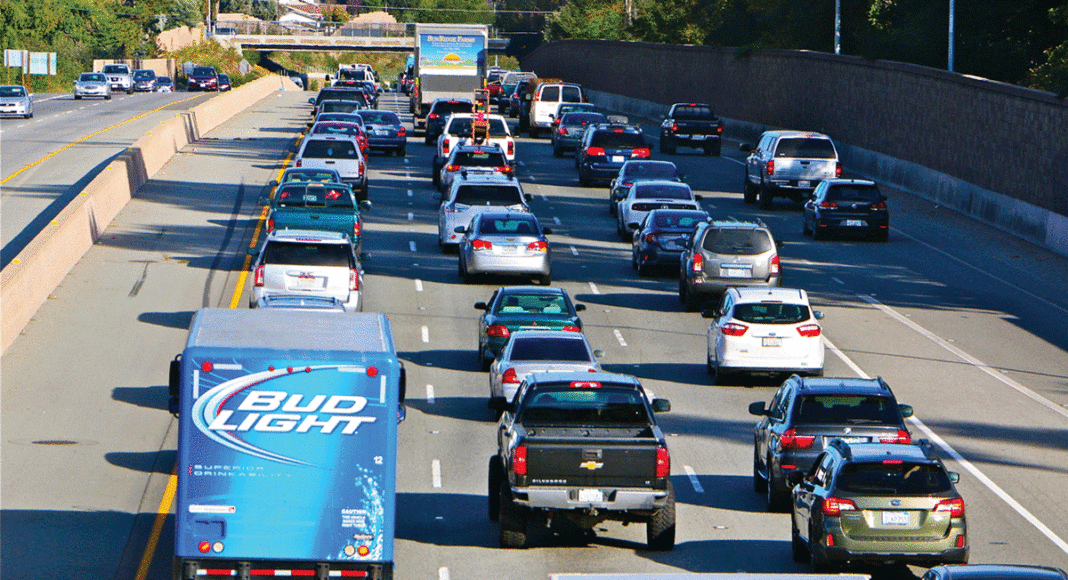Santa Cruz County transportation planners have released a new environmental report detailing the impacts of a partial widening of Highway 1.
The new draft environmental impact report (EIR) studies the impact of extending the congested highway’s width from the Capitola/Soquel area to Aptos. The Santa Cruz County Regional Transportation Commission (RTC) already finalized the high-level EIR for the entire project, as well as a detailed analysis of widening from Soquel Avenue to 41st Avenue, in January 2019.
The latest EIR, released Thursday, covers the final legs of the proposed project from Bay Avenue and Porter Street area to State Park Drive. A public comment period is now open.
The RTC’s plan is to build new merge lanes, or auxiliary lanes, very much like the ones between Morrissey Boulevard and Soquel Avenue that opened in 2013.
Auxiliary lanes are a get-what-you-pay-for version of highway widening. These aren’t through-lanes that allow people to cruise through for miles on end. Instead, they run from each onramp to the subsequent offramp. Building axillary lanes doesn’t increase a highway’s road capacity in the same way that building actual carpool lanes—or high-occupancy vehicles (HOV) lanes—would. Auxiliary lanes also don’t incentivize ridesharing. If all someone cares about is getting places faster by car, these are both downsides. The upside is that auxiliary lanes are far cheaper to build than full-blown highway widening.
That may be why a transportation sales tax measure built mostly around a plan to build new HOV lanes failed disastrously at the polls in 2004.
So in 2016, the RTC crafted a cheaper sales tax measure, Measure D. In the reboot, transportation stakeholders took a different tack. Only one quarter of the money—the second-biggest slice in the measure—would go toward new auxiliary lanes. Measure D then passed, with voter support coming in 24% higher than it did in the 2004 version. That gave the auxiliary lanes the funds to move forward, and the RTC is proceeding accordingly. (The RTC is still signaling an intention to build HOV lanes, but that would be after 2035, and it has no idea at this point how to pay for them.)
Simultaneously, RTC staff is studying a concept called bus-on-shoulder, which is what it sounds like. The plan would allow buses to drive down the shoulder on the edges of the highway.
One issue, though, is that, when engineers also put in an auxiliary lane, that doesn’t leave a whole lot of room for buses trying to avoid heavy traffic flows. It’s something environmental activist Rick Longinotti has been thinking about.
“They’re calling it bus-on-shoulder, which is to me a sleight of hand,” says Longinotti, a leader of the Campaign of Sustainable Transportation, which has opposed various highway widening proposals over the years. In general, Longinotti is optimistic about the potential for bus-on-shoulder, depending on how it’s done. He has started reading through the new draft EIR and will be submitting comments.
The RTC’s current bus-on-shoulder plans call for buses to drive down the auxiliary lanes, which are mostly meant for cars merging onto and off of the highway, and they can get quite congested in their own right. There are also stretches between certain offramps and onramps, which will be for buses only, but those sections are rather short, typically less than 100 yards long.

Although he acknowledges that it may not be exactly what voters approved, Longinotti thinks the RTC should use the auxiliary lanes for buses only. He also wrote the California Transportation Commission Tuesday asking its members to deny grant requests to the RTC for auxiliary lanes as they are currently planned.
In addition to auxiliary lanes, the new EIR covers the impacts of bus-on-shoulder and a proposed Mar Vista Bicycle/Pedestrian Overcrossing. That bridge, which Mar Vista Elementary School families first requested some 18 years ago, should begin construction in 2023, according to an informational video released in September.
The public comment period on the latest EIR runs through Jan. 11 at 5pm.
There will be a virtual public hearing Tuesday, Dec. 8, from 5-6:30pm. Attendees should register ahead of time at bitly.com/Highway1-SC (URL is case sensitive).













